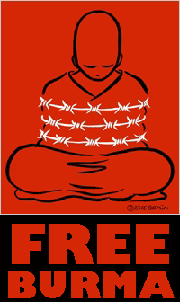
|
|
|
Home Asia Pacific South East Asia Myanmar Myanmar Protest News Hunted Myanmar Monks Flee MonasteriesBy AMBIKA AHUJA and RUNGRAWEE C. PINYORAT, (AP), Nov 12, 2007BANGKOK, Thailand -- The monasteries of Myanmar used to teem with saffron-robed Buddhist monks, revered as spiritual guides and moral authorities in a country in the grip of a repressive military regime.
Now, nobody knows how many of Myanmar's more than 500,000 monks are left in their monasteries. The junta has not disclosed how many monks were put behind bars since the upheaval of Sept. 26-27. In its last tally, on Nov. 6, the regime said nearly 3,000 people had been released, leaving 91 still in custody. But diplomats and dissidents say the figures are a fraction of reality and an unknown number of monks have been detained since then. The picture that emerges, after scores of interviews with monks, abbots and other people in Myanmar, is that monasteries around the country have been depleted — particularly in the biggest cities, Yangon and Mandalay, where protests were staged. Many monks have slipped over borders or are hiding in their hometowns and villages. To avoid being caught in a nighttime raid on their monasteries, some stay with friends, despite Buddhist rules that forbid a monk and a lay person to sleep under the same roof.
But many parents are keeping their children out of the monasteries for their safety, several abbots said in interviews. The junta has lifted a nighttime curfew, restored Internet access and ended a ban on assembly. But monks remain targets. The junta said recently it was still pursuing four monks who led rallies. One of them, U Kovida, spoke to The Associated Press from the Thai border, asking that his location be kept secret for fear Thai authorities would send him back. "At the moment you will hardly find a monk in Yangon. Monks are running away from danger. They are being arrested and sent to labor camps, tortured and killed," said U Kovida, 24. The junta has not commented on allegations of abuse. Kovida is officially accused of having hidden 48 blocks of TNT in his monastery before moving them elsewhere. He was hunted for three weeks by authorities and arrived at the border Oct. 18. He says the allegations are false. "Whenever they want to arrest a leading monk, they have to make up some story because they know people have such great respect for monks and Buddhism," he said. A heavy police guard remains outside a handful of monasteries in Yangon, the former Rangoon, where some of the country's best-known shrines were flashpoints of the violence. But a tour of some of the monasteries indicate there's little left to guard. The Ngwekyar Yan monastery in northern Yangon is empty. It used to have about 180 monks, said U Yewata, the chief abbot, who was ordered by officials to move out. He said 70 monks were dragged away on the night of Sept. 26 and more were arrested later. An abbot at a monastery in Ahlone township, in western Yangon, said he had sent most of his 1,200 monks home fearing he could no longer control them. Only the elderly monks remain. Residents of North Okalapa township in northern Yangon said when a traditional daily procession of monks failed to show up they went to the monastery and were told that hundreds of monks had left and only a few dozen remained. Monks have played a pivotal role in protests against unjust rulers, from British colonial powers to the repressive military regime. The last time monks took to the streets was during 1990 anti-government protests, which the junta crushed. The junta has long regarded monks as a potential threat. It has tried to intimidate, bribe and spy on them, and to gain control over the official state committee of monks, giving some of its 47 members cars, cell phones, TV sets, refrigerators and other gifts considered luxuries in the impoverished country formerly named Burma. But many say that this time, in targeting monks and monasteries, the generals went too far. In this 90 percent Buddhist country of 54 million people, monasteries are sacrosanct. At the height of the crackdown, news footage broadcast around the world showed troops firing on marching monks and smashed-up furniture at monasteries. A dead monk was shown floating face down in a river. For now, the generals appear to have succeeded in scaring monks into submission. Josef Silverstein, a retired Rutgers University professor who studied Myanmar for more than a half century, doesn't expect to see monks back in the front line for some time. "Religious sayings and prayers were no match for the guns and determination of the military," he said. But other experts say the monks' treatment won't be forgotten. "The next wave of protests may have to be led by student leaders and political activists," said Pornpimon Trichot, a Myanmar specialist at Chulalongkorn University in Bangkok. "But monks will remain an inspiration that lends legitimacy to the movement." ---------------------------- |
 Get your Korean Buddhist News here, brought to you by BTN-Buddhist Channel |
 |
 The Mandala app brings together Buddhist wisdom and meditation techniques with the latest insights of psychology and neuroscience to handle the challenges and complexities of modern life. The App offers a series of engaging talks and conversations with experts on a wide variety of topics, such as managing stress, dealing with adversity, developing greater resilience, cultivating empathy and compassion, creating healthy relationships, and many more. These topics are explored to help find greater peace, meaning and joy in our lives. Our panel of experts include Dr, Thupten Jinpa, Daniel Goleman, Kelly McGonigal and others.FREE DOWNLOAD here |
| Point
your feed reader to this location |
| Submit an Article |
| Write to the Editor |

 Then the junta turned its troops on the monks, beating them in the streets for leading pro-democracy protests. They also raided their monasteries, leaving bloodstains on the floors, chasing anyone who had participated in the rallies.
Then the junta turned its troops on the monks, beating them in the streets for leading pro-democracy protests. They also raided their monasteries, leaving bloodstains on the floors, chasing anyone who had participated in the rallies.